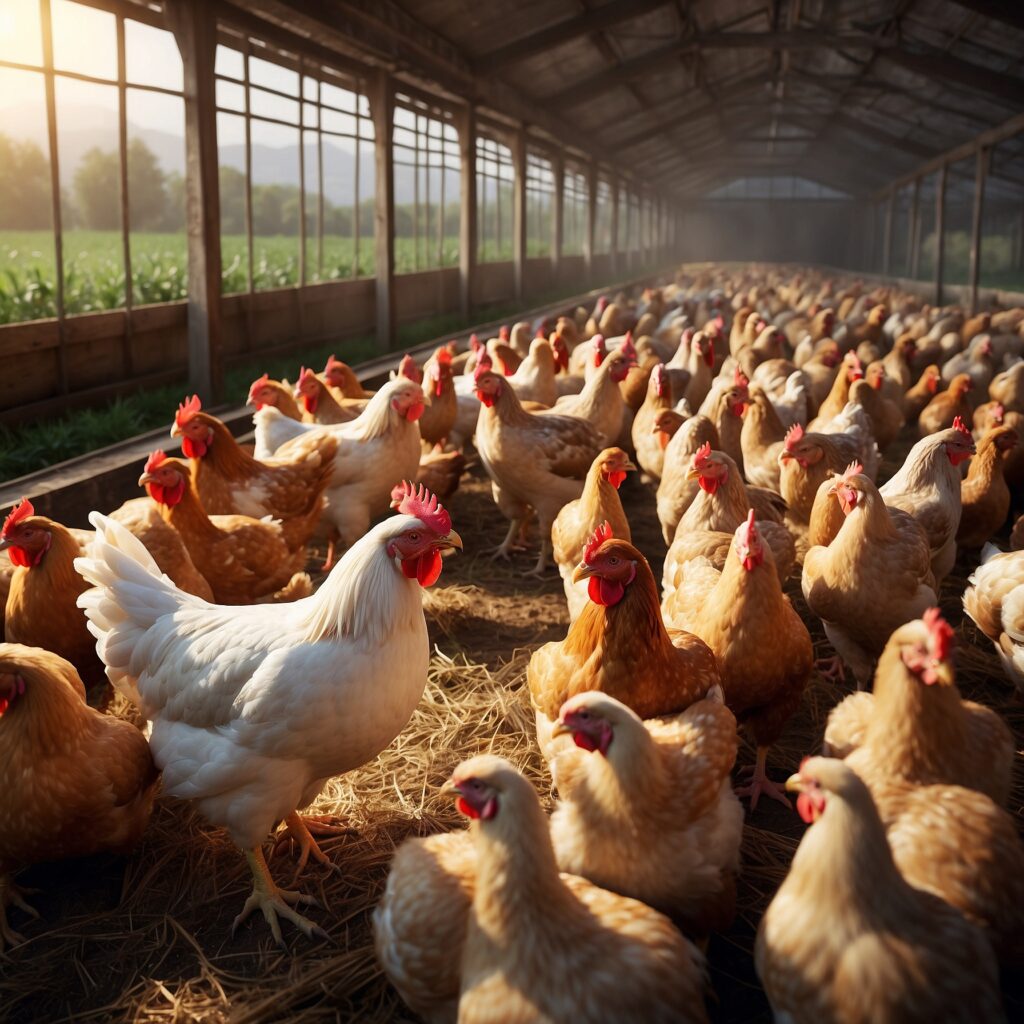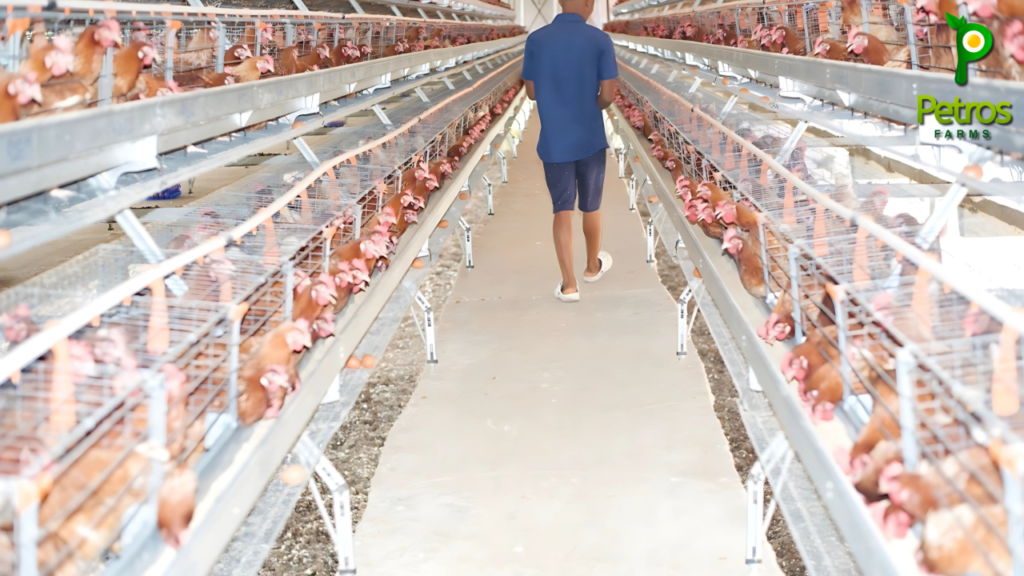02 Feb Egg Drop Syndrome: What Poultry Farmers Need to Know
Egg production is the cornerstone of many poultry farms across Africa, providing a reliable source of income and food security. However, one challenge that can significantly affect productivity is Egg Drop Syndrome in poultry. This disease, caused by a virus, leads to a sudden decline in egg production, affecting both the quantity and quality of eggs. For African poultry farmers, understanding and managing Egg Drop Syndrome in poultry is critical to maintaining a profitable and sustainable farm.
What is Egg Drop Syndrome?
Egg Drop Syndrome (EDS) is a viral disease that primarily affects laying hens. It is caused by the Duck Adenovirus A (DAVA), which can infect chickens through contaminated equipment, water, or wild birds. The disease often goes unnoticed until egg production declines, making early detection and prevention crucial.
Signs and Symptoms of Egg Drop Syndrome
Recognizing the signs of EDS can help farmers take swift action. Common symptoms include:
- Sudden Drop in Egg Production: Hens produce fewer eggs than expected, often without any noticeable change in their health.
- Poor Eggshell Quality: Eggs may have thin, soft, or shell-less surfaces, making them unmarketable.
- Irregular Egg Shape: Affected hens may lay eggs with abnormal shapes or textures.
- No Visible Illness: Unlike other poultry diseases, EDS does not typically cause obvious signs of illness in hens.
How Egg Drop Syndrome Affects Poultry Farms
The impact of EDS extends beyond just a drop in egg numbers. For African poultry farmers, this can mean:
- Reduced Income: Fewer eggs to sell leads to lower revenue.
- Wasted Resources: Feed and care for hens continue, even as egg production declines.
- Market Loss: Poor-quality eggs can damage a farm’s reputation and lead to loss of customers.
How Egg Drop Syndrome Spreads
The virus responsible for EDS is highly contagious. It spreads through:
- Contaminated feed, water, or equipment.
- Contact with wild birds or waterfowl that carry the virus.
- Poor biosecurity practices that allow infected material to enter the farm.

Prevention and Control of Egg Drop Syndrome
Preventing EDS requires proactive management and adherence to biosecurity measures. Here are the key steps:
- Vaccination
- Administering a vaccine against EDS is one of the most effective ways to protect your flock. Vaccines are typically given to pullets at 14–16 weeks of age before the onset of egg production.
- Biosecurity
- Limit access to your farm to essential personnel only.
- Disinfect equipment and vehicles entering the farm.
- Keep wild birds and waterfowl away from your poultry houses.
- Clean Water Supply
- Ensure a clean and uncontaminated water source, as water is a common transmission route for the virus.
- Monitor Egg Production
- Regularly track egg production trends. A sudden drop in egg output can indicate the early stages of EDS.
Strengthening Biosecurity to Prevent Egg Drop Syndrome
Biosecurity is the cornerstone of disease prevention in poultry farming, and its importance cannot be overstated when tackling Egg Drop Syndrome (EDS). A robust biosecurity program involves implementing strict measures to prevent the introduction and spread of the virus responsible for EDS. Below are detailed biosecurity practices tailored for African poultry farms, focusing on disinfection protocols and worker hygiene.


Disinfection Protocols for Poultry Farms
Disinfection is a critical step in breaking the transmission cycle of diseases like EDS. Proper disinfection protocols ensure that the virus is eliminated from surfaces, equipment, and the environment.
- Disinfect Equipment and Tools
- Clean and disinfect feeding troughs, waterers, and any equipment used in the poultry house daily.
- Use effective disinfectants like quaternary ammonium compounds, formaldehyde, or chlorine-based products. Ensure the disinfectant is approved for poultry use.
- Footbaths
- Place footbaths filled with disinfectant at the entrances of poultry houses.
- Replace the disinfectant solution regularly, as organic matter (dirt, feathers) can reduce its effectiveness.
- Cleaning Poultry Houses
- Conduct thorough cleaning of the poultry house before introducing new birds. This includes:
- Removing all organic matter (manure, feed residue).
- Washing surfaces with detergent and water.
- Applying disinfectant to all surfaces, ensuring proper contact time as specified by the product label.
- Conduct thorough cleaning of the poultry house before introducing new birds. This includes:
- Allow the house to dry completely before restocking.
- Waste Management
- Dispose of poultry waste, including manure and eggshells, in a designated area far from the poultry houses.
- Compost waste properly to kill pathogens before using it as fertilizer.
- Water and Feed Sanitation
- Regularly clean and disinfect water tanks, pipelines, and feeders.
- Use water treatment solutions to eliminate potential contaminants, especially in areas where water quality is poor.

Worker Hygiene Practices
Farm workers are a significant potential source of disease transmission. Implementing strict hygiene protocols for anyone entering the poultry farm is essential.
- Dedicated Farm Clothing and Footwear
- Provide workers with farm-specific clothing and footwear that never leaves the premises.
- Use disposable boot covers when entering high-risk areas.
- Hand Hygiene
- Install handwashing stations with soap, water, and hand sanitizers at strategic locations around the farm.
- Ensure workers wash their hands thoroughly before and after handling birds, eggs, or equipment.
- Restrict Access
- Limit access to poultry houses to essential personnel only.
- Maintain a visitor logbook and deny entry to anyone who has been in contact with other poultry farms within the last 48 hours.
- Regular Training
- Train workers on the importance of biosecurity and how their actions can impact flock health.
- Reinforce training regularly to keep biosecurity practices fresh in their minds.
- Health Monitoring
- Monitor the health of farm workers. Sick workers should not handle birds, as they may unintentionally spread pathogens.

Additional Biosecurity Measures
- Wild Bird and Rodent Control
- Install netting or screens to keep wild birds, which can carry the EDS virus, out of poultry houses.
- Use bait stations and traps to control rodents that may spread the virus.
- Quarantine New Birds
- Isolate new or returning birds for at least two weeks before introducing them to the existing flock. Observe for any signs of illness during this period.
- Segregation of Flock Areas
- Separate layers by age group to prevent the spread of diseases between different flocks.
Implementing Biosecurity Audits
Conduct regular biosecurity audits to ensure compliance with protocols. Audits can help identify gaps in practices and allow for timely corrective actions. Engage veterinarians or poultry health specialists to review and improve your biosecurity measures.
Treatment Options for Egg Drop Syndrome
Unfortunately, there is no specific treatment for EDS once it affects a flock. However, supportive measures can minimize the damage:
- Provide optimal nutrition to maintain overall flock health.
- Isolate affected birds to reduce the spread of the virus.
- Improve environmental conditions in the poultry house to minimize stress.
Why African Poultry Farmers Should Act
For African poultry farmers, diseases like EDS pose unique challenges due to limited access to veterinary services, vaccines, and diagnostic facilities. However, by investing in preventive measures, you can protect your flock and secure your livelihood.
Key Takeaways for African Poultry Farmers
- Stay Vigilant: Regularly monitor egg production and egg quality for early signs of EDS.
- Vaccinate Your Flock: A preventive EDS vaccination program can save your farm from devastating losses.
- Strengthen Biosecurity: Keeping the virus out of your farm is the best defense.
- Collaborate with Experts: Work with local veterinarians or agricultural extension officers for guidance.
Egg Drop Syndrome is preventable. By taking proactive measures, African poultry farmers can avoid the financial and operational setbacks caused by this disease. Protect your farm, your hens, and your future by prioritizing EDS prevention today.
For more tips and resources on poultry farming, stay connected with Petros Farms, your trusted partner in sustainable egg production across Africa.
Cheers.
Petros Farms
Share with:
